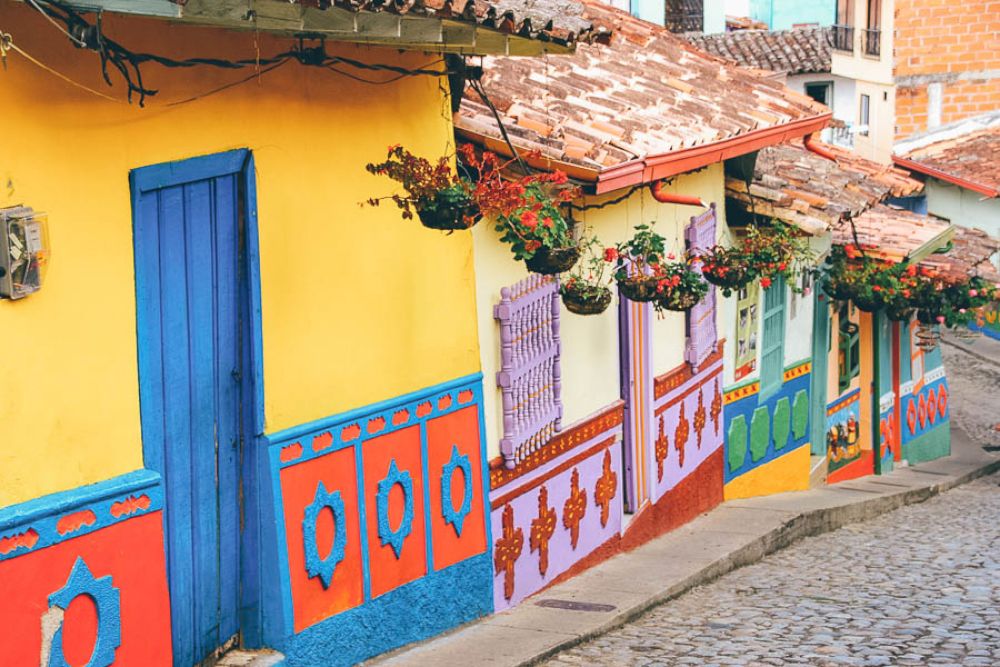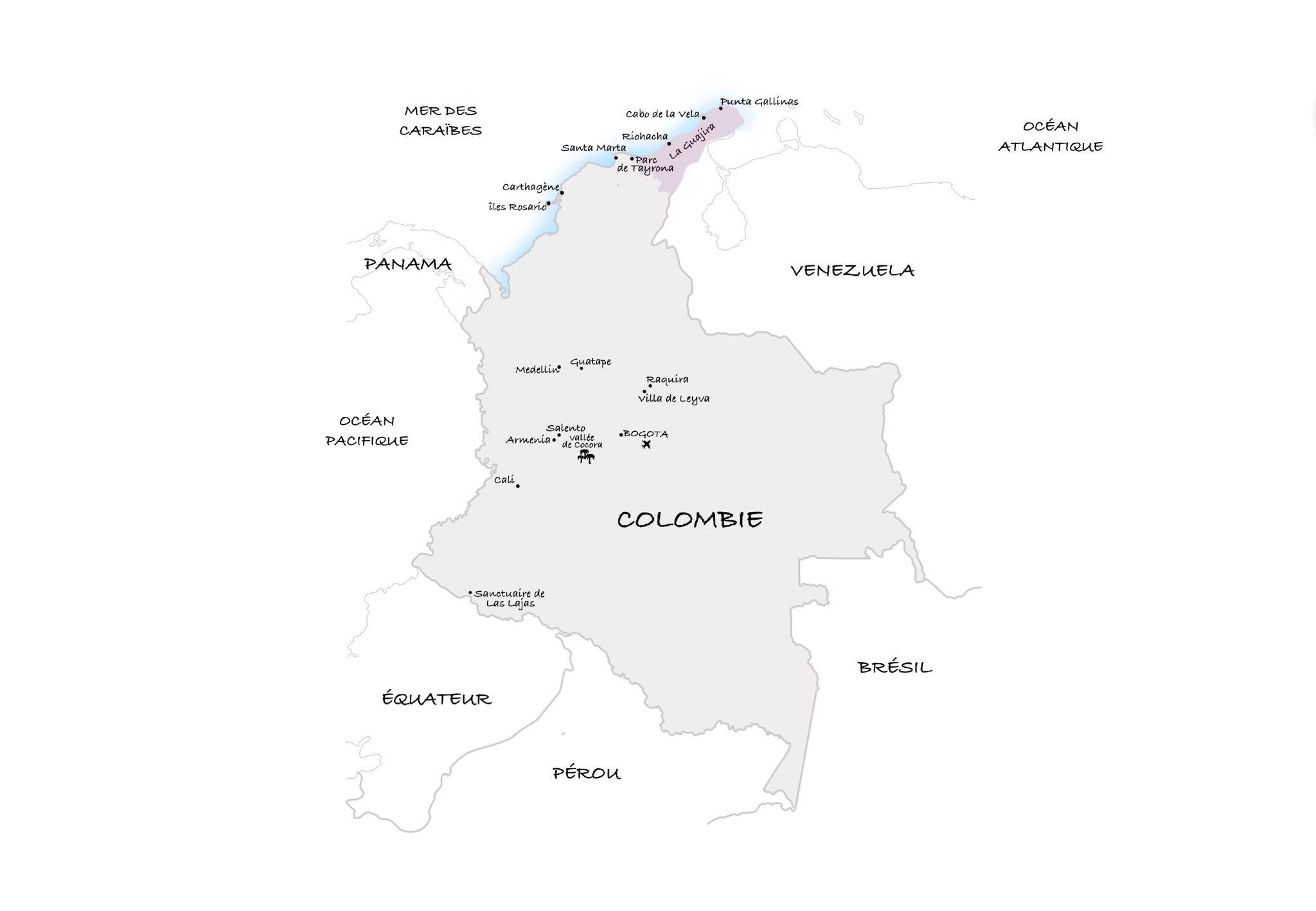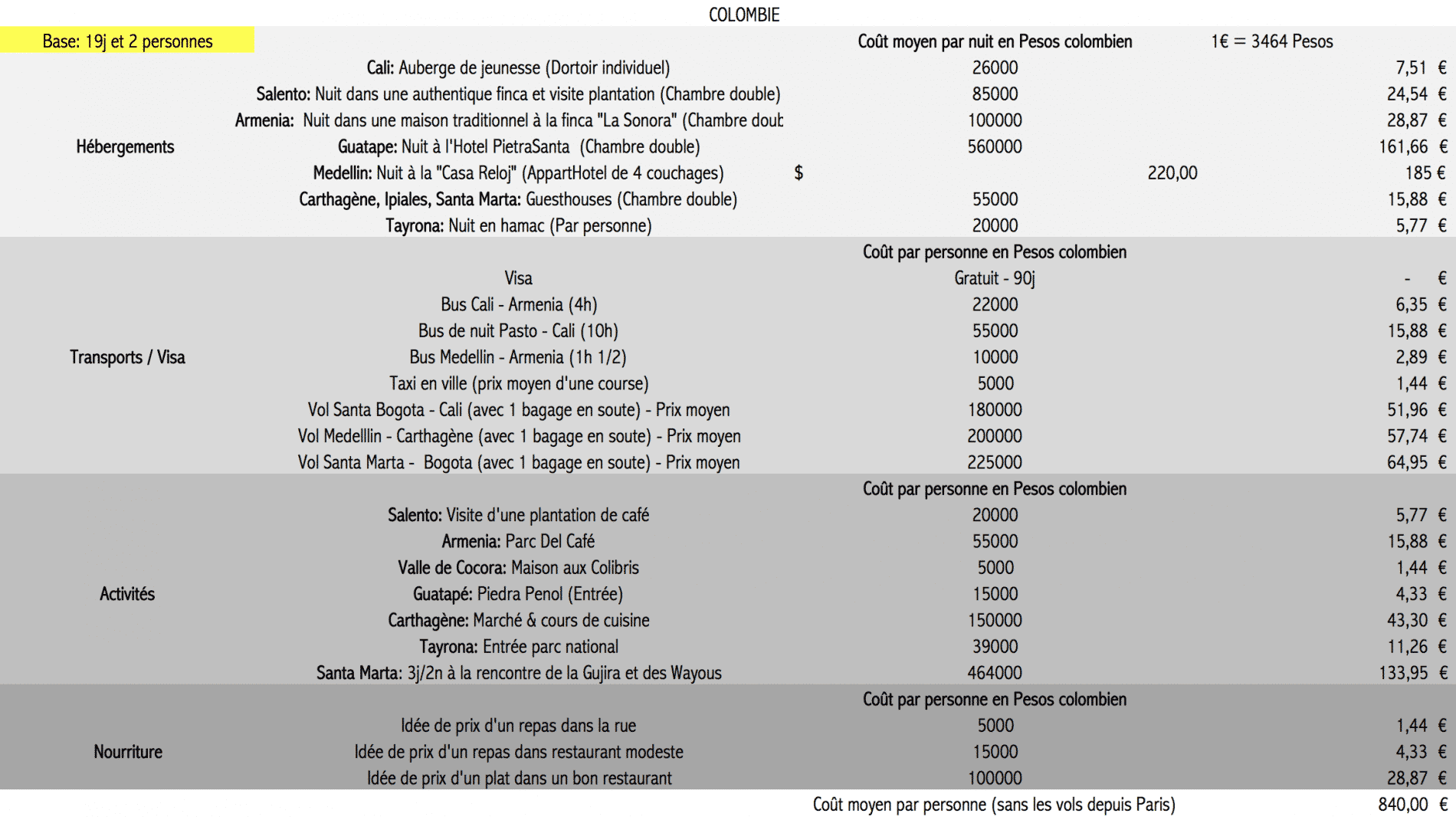
Discover our 3-week itinerary in Colombia and our detailed fact sheet to help you prepare for your trip.
Colombia was our favorite destination in South America. A welcoming country, as colorful as its people and landscapes. A country of contrasts, with lush inland regions and the more arid Caribbean coast. We invite you to discover our 19-day itinerary, which begins in the south of the country at Ipialès, continued through the center of the country in the Cocora before setting sail for the Caribbean coast of Cartagena at the northern tip of Guajira, South America’s most northerly point
| Sanctuary of Las Lajas: A church like no other… (a must if you come from Ecuador)
| Cali: Discover Colombian-style salsa
| Salento: Village tour, visit to a coffee plantation and trek into the Cocora valley to meet the hummingbirds.
| Armenia: Parc Del Café, a family amusement park
| Guatape: Visit to the village, Piedra de Peñol, kayak trip from the PietraSanta hotel
| Medellin: Visit to Arbi Park and the “El Poblado” district
| Cartagena: City tour, market and cooking classes, excursion to the Rosario Islands
| Santa Marta: 2-day excursion to Tayrona Park, then 4 days in Guajira
| Villa de Leyva & Raquira: Visit the town, its market and the village of Raquira, famous for its pottery.
| Bogota: Return airport

I invite you to read all our other articles on Colombia to help you prepare for your trip:
- Charming villages: Salento, Cocora Valley, Villa de Leyva and Raquira
- The Guajira region and encounters with the Wayuu people
- Medellin, what to do and where to stay in this city
- Cartagena, what to do in this city
- A cooking class in Cartagena
- Santa Marta and Tayron Park, all our practical advice
- Explore the Armenia and Salento regions, renowned for their coffee production
- Guatapé and its unusual, charming hotel
- Playa blanca, why we are disappointed with this beach
– 6h (winter time) and -7h (summer time) with Paris
The local currency is the Colombian peso, spelled “$”, not to be confused with the US dollar. 1€ = 3526 COP
In tourist areas, no vaccinations are required. If you’re planning a trip to the Amazon, opt for an anti-salt treatment. Vaccination against yellow fever may be required; check with the Institut Pasteur.
No visa is required for French nationals if your stay does not exceed 90 days. Did you know that since May 2015, Colombia has signed an agreement with France to develop tourism among the under-30s? So it’s time to think about Working Holidays Visa (WHV) and to spend 1 year discovering this magnificent country. You’ll be able to work on site and finance your trip. More information here
Colombia is equipped with 2 parallel flat plugs like American sockets with 110V current (idle current). So don’t forget a universal adapter and external batteries, just in case.
The range of accommodation in Colombia is varied: top-of-the-range hotels, standard hotels, apartment hotels, overnight stays in fincas, hammocks…
Whatever your mode of travel and your requirements in terms of comfort, Colombia is a very affordable country, and a night in a double room in a guesthouse will cost you just under €20. A room in a top-of-the-range hotel will cost you around €160, and in a standard hotel €40. What we like to do is alternate between authenticity in a guesthouse and comfort in a more upmarket hotel.
→ Flights
If you take off from Paris, there is a direct flight at Air France, which makes Paris -> Bogota. With the company Avianca, you’ll make a stopover in Caracas, Venezuela. The company has a good reputation among travelers. Transatlantic flights are expensive! Count between 650€/p and 1200€ for a return flight depending on the period. As for domestic flights, they’re not very expensive in Colombia, so don’t miss out on some flea-bitten hops to save on comfort and time. These include Avianca and Latam offer flights at around €100 with a 23kg hold bag. Beware: some domestic airlines offer competitive fares, such as sixty euros a flight, but they impose a maximum weight limit that often doesn’t exceed 15-20kg (and yes, they do have to make up for these costs, the famous extra kilos you hadn’t thought of). We had checked flights when we were in Colombia and had no trouble booking our seats on their website. If you have time, book them in advance.
→ Bus
For overland travel and closer connections, the bus network is the most economical option. It’s highly developed and very affordable. Connections are less frequent than in Peru, so be patient. Some companies don’t want to run empty and wait until the bus is full. Seats are often numbered, and the locals are quite respectful about this. Buses are often equipped with air-conditioning or fans, and the luggage compartments are large enough to accommodate your luggage. Have the reflex to look out of the window as soon as the bus stops at a station, just to make sure your suitcases haven’t gone elsewhere…
Buses often stop on the outskirts of town, at bus terminals. You’ll need to pay for a cab to get to the hotel, which costs between 5,000 COP and 20,000 COP. We recommend 3 companies:
- Transportes Gonzales
- Marsol Transportes
- Expreso Brasilia operates throughout the country and has a fairly good reputation.
→ Taxis
Finally, in the cities, you can travel by yellow cabs because they’re so affordable. Remember to negotiate the fare beforehand, and always ask a local for the fare to avoid being ripped off! A few tips: look for the cab rank in town or ask your hotel to call you a cab, as they’ll make sure you get the right price and destination.
→ Car rental
Yes, you can rent a car, but be careful not to venture onto uncontrolled roads. The locals drive fast and badly, and traffic laws are not the same as ours. You mustn’t get angry at the wheel or shout at them because they’ve overtaken you on the right….The wisest thing to do would be to hire the services of a driver. If you’re interested in this option, you should know that as a tailor-made travel designer, I can find you a driver for the duration of your trip.
Colombian gastronomy is all about fruit. You’ll find all kinds of exotic fruits, and you’ll often have the opportunity to make yourself a little juice. We had become addicted to our passion fruit juice. In the street, you’ll find many stalls offering potato specialities, meat kebabs (mainly chicken), but also a wide range of other products patacones (mashed and fried plantains), but also pan con queso (cheese bread), and empanadas (an Argentinian speciality, a turnover filled with meat or cheese), and arepas (cornflour pancakes with fillings). On the Caribbean coast, you’ll eat chicken, beef and fish, often fried and accompanied by rice, red beans and coconut, as well as ceviche and seafood. In the restaurant, dishes are fairly European (pizzas, pasta, toast…) and generally quite good. Colombians love French fries, and eat them in large portions, drizzled with mayo and ketchup sauce and little sausages!
Colombia is a coffee-producing country, so you won’t be disappointed! If someone offers you a “tinto” in the morning: don’t worry, it’s coffee, not red wine. This is a basic black coffee usually served in a small cup. If you would like a more sophisticated coffee, please visit the Juan Valdez, the strarbuck local. The local drink is Guarapo, an iced juice made from sugar cane and lemon. Also try the coconut lemonade, a little sweet for my taste, I prefer natural juices. The local spirit is Aguardiente, a type of pastis. We often drank their beers, Aguila, Bogota Beer company or even Club Colombia.
Colombia is the South American country where we felt safest. The days of Farcs are over, and there are no more risks than in other countries. The people are mostly friendly, and despite the fact that you have to be careful at certain times of the day in the big cities, you’ll feel right at home in this beautiful country. Drugs? of course there are, and it’s very easy to get hold of them, as you’re always in demand on the street, especially in the evening. It’s up to you not to give in. Colombians are like most Latinos, a bit of a charmer and a flirt. Don’t be surprised to hear: “hola mi amor, belleza, hola guapa, guapisima…” these are indeed flirting techniques, but they’re not really mean. Smile and say thank you… gracias! You won’t have any trouble traveling if you’re a single woman or traveling with girlfriends.
Packing for Colombia is not very complicated. Temperatures are warm enough without being stifling, so you’ll often be dressed lightly. So there’s no need to pack your suitcase full of warm clothes. Just bring something to cover up for the cooler evenings inland. Remember to take a good sun cream and some mosquito repellent. You’ll need a Kway, a waterproof windproof jacket, sneakers you’re comfortable walking in, light pants, a few dresses, shorts and tee shirts.
You’ll have plenty of souvenirs to bring back: from mochila bags hand-woven by Wayus women (visit here) through to musical instruments, hammocks, decorative objects, but also precious stones such as Emerald. Did you know that Colombia is the world’s leading producer? In Bogota, there’s a dedicated market.
Colombia’s proximity to the equator means that the weather is almost always warm and sunny. So you can visit all year round. The best period is from November to January as temperatures are a little milder there, but it’s also the Colombian vacation season in January, so there are lots of people. Inland, the rainy season runs from April to June, making these months a little less favorable, but not disturbing. May to August are the months when rainfall can be expected. These rains often don’t last all day!
INFOS PRATIQUES | Colombie
We list below some price ideas in 2015, when you’re traveling in backpacker/backpacker mode, often sleeping in dormitories, taking local transport, night buses, snacking at markets… Please note that not all expenses have been noted! For those who want a customized quote, Colombia is not a cheap country as services increase quite quickly on custom due to the driver guide francophone, hotel category, car rental, distances, experiences…
To give you an idea of the budget, Colombia in backpack mode would cost around 34€/person/day. The average stay is around 15 days to 3 weeks. Transportation and food represent a major part of your trip, around 55% of your budget, followed by accommodation and activities. We like to treat ourselves, not deprive ourselves, so our budget was more between 45€ and 50€/p.

Before you leave, don’t forget to read all our other articles on Colombia to help you prepare for your trip:
- Charming villages: Salento, Cocora Valley, Villa de Leyva and Raquira
- The Guajira region and encounters with the Wayuu people
- Medellin, what to do and where to stay in this city
- Cartagena, what to do in this city
- A cooking class in Cartagena
- Santa Marta and Tayron Park, all our practical advice
- Explore the Armenia and Salento regions, renowned for their coffee production
- Guatapé and its unusual, charming hotel
- Playa blanca, why we are disappointed with this beach
Please note that, as an accredited tailor-made travel designer, I can help you create your own personalized itinerary for your stay in Colombia. Please send me an email at : contact@mademoiselle-voyage.fr

